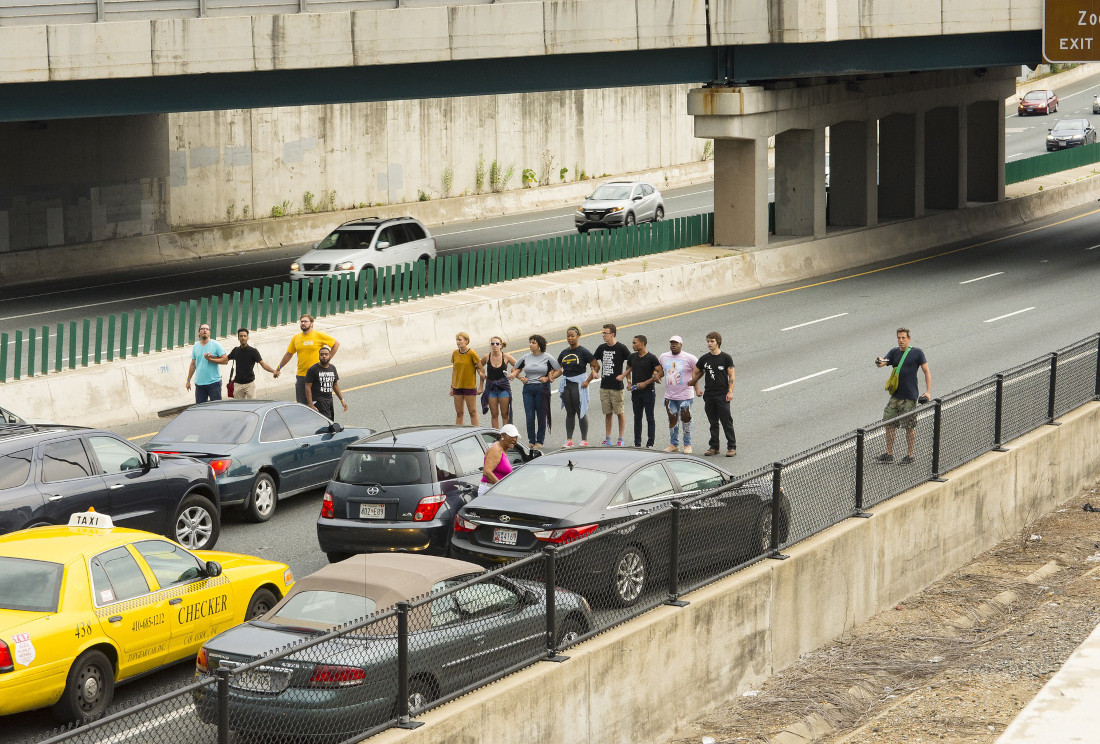The potential for harm between seats and streets
Recent vehicle ramming at Winnipeg demonstrations
Protesters blocking a street in Baltimore. Two recent incidents of vehicles ramming local protesters are part of a disturbing trend. (Supplied photo)
Two days before the article was published, a truck driver drove through a climate rally on Portage Avenue, hitting several protesters. Two days after the article was released, a member of the University of Manitoba Faculty Association (UMFA) was hit by a vehicle on the picket line.
Shawn Kettner, an organizer with Manitoba Energy Justice Coalition (MEJC), which hosted the event on Oct. 29, says the protest was intended to pressure the Royal Bank of Canada to divest from its $208 billion investment in the fossil-fuel industry and financial stake in the silica sand mine project in development near Hollow Water First Nation.
After speeches from Sadie-Phoenix Lavoie, Brielle Beardy-Linklater, Marcel Hardisty, Quinn Amos and Sharon Wall, Kettner says the Indigenous youth leading the event felt it would be right to occupy the streets for a while, despite this not initially being part of the day’s plan. Kettner says there were safety marshals present, and the group occupied sections of Portage Avenue in the middle of a block.
She says that while the groups were on the south side of Portage, the energy from protesters and traffic was very positive. “Then we moved on to the north side of Portage, and it was fine, but then this guy in a truck just wasn’t going to wait any longer and started pushing with his big, huge truck.”
“Nobody got hurt, but it’s scary. It’s a scary thing when a vehicle touches you. It was shocking, and it was upsetting to see somebody take somebody else’s safety so lightly,” she says.
Kettner believes MEJC is ultimately responsible for keeping volunteers safe at events like this, and the group should have occupied at an intersection where they could have gone on and off of the street in accordance with the traffic light, which would have also given the benefit of a wider, rotating audience.
Orvie Dingwall, president of UMFA, says the association is on strike against the University of Manitoba (U of M) administration because the administration does not provide sufficient compensation to keep the university competitive and has not kept the U of M autonomous and independent. The strike has multiple picket lines at the Fort Garry campus, Legislature, Bannatyne campus and online, with strikers only impacting traffic at the Fort Garry picket line.
“Sometimes, it’s very unfortunate, drivers aren’t respectful of our right to picket and our right to be on strike,” she says. “We have encountered some aggressive drivers, and in one unfortunate incident on our first day of picketing, one of our members was struck by a vehicle. They are doing okay, but we ask as people are encountering our pickets that they are respectful. They’re not going to be there for very long.”
“Safety for our members is obviously our primary concern for our members when they’re out on the picket line,” she says. “We do all of the standard protocols: wearing safety vests, using traffic cones, timing how long we’re stopping traffic for. We have police liaisons, and the university has security vehicles out.”
Published in Volume 76, Number 10 of The Uniter (November 18, 2021)







